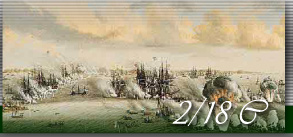
Военная история 2-й половины 18 века |
|
|
 |
|
|
|
The armed forces of Sweden during the Swedish - Russian war in 1788-1790The armed forces of Sweden during the Swedish - Russian war in 1788-1790(Written by Lars Rössle, all rights reserved) OrganisationThe army and navy were basically organised in the same way as during the Great Nordic War (GNW) 1700-1721. The army was organised in regiments, but for tactical use the regiment was divided into two battalions. Often one battalion was sent to the front while the other was kept at home for reqruting and training replacements or to serve as a reserve in case of a war in a new direction. It was quite common that the one regiment served on different fronts. There were no fixed organisations like divisions or brigades, except the Savolax-brigade in Finland. The changes within the army were that the former Danish province of Scania (Skåne), recruited two allotted cavalry regiments. Due to the loss of the greater parts of Carelia to Russia, one cavalry regiment was disbanded and the Wiborgs infantry regiment was reduced to a small Jaeger battalion.
The most important changes were the forming of the Archipelago fleet (Skärgårdsflottan), also known as the Armys fleet (Arméns flotta). The names give a good description of its role. Equipped with vessels specially designed for operations in the archipelagos they were to conduct offensive landings in the rear of the enemy front, and to prevent the enemy to do the same. In that way they could fill the gap between the land forces and the "Great Navy". RecruitingThe regiments were recruited in two ways, enlisted (värvade) or through the "allotment" system (indelnings verket). The enlisted units were full time soldiers and were kept as garrison units in the major cities, or on guard duty at the Russian and Norwegian borders. The allotment system was a unique Swedish system that may require some additional explanation. The allotted (indelta) soldiers were professionals as the enlisted, but were recruited and payed in a different way. A group of households (3 to 5) were responsible to recruit and to support a soldier. While on contract the soldier had a small cottage and a piece of land to feed himself his family. Maybe he was more a farmer than soldier, but they had on several occations proved to be equals or superior to many foreign armies. Why? The fact that they wasn´t forced into servise can be one. It was infact, among the "little people" it was regarded as a good job and they had a rather high social status in the willage. Uniform m/1783When the war broke out, the army was equipped with uniform m/1783. The uniform was designed by King Gustav III and it's quite obvious that it's main purpose was to look good, not to be sutible in field. It was regulated that the soldiers were to use powder or a white wig at all time. Most of the units had uniforms of the same cut, but the colours on some details differed. In general it was different combinations of dark blue, yellow, red and white. The hat was black and it was decorated with a yellow plume and some fethers in various colours. The band around the hat was white (officers yellow metal). The jacket was dark blue and short. The colour of the cuffs, collor differed. Some units also had tha lapells in a ditinctive colour. The pants were of the regular model, tight and of knee length. The colour was blue, white or yellow. The stockings were also in blue, white or yellow. The shoes was called "Hungarian boots", light and pointy. The belts were all white. The officer's uniform differed in some details, but had the same colours as the troops but it was made in a finer quality. Firstly the jacket had shoulder pads. Secondly, the waistband was made of blue silk. Third, a white tie was worn around the left arm to honour the coup d state of Gustav III in 1772. To veiw details of the uniforms, please goto the Swedish War archive's web-site (KRIGSARKIVET Carl Gustaf Roos: Samling af Swenska armeens uniformer, 1783.) or Pictures of Swedish uniforms and colours from 1769 to 1819. The Images for this page are taken on Hans Högmans Släktforskning and Militärhistoria och historiska figurspel |
Поиск / SearchСсылки / linksРеклама |